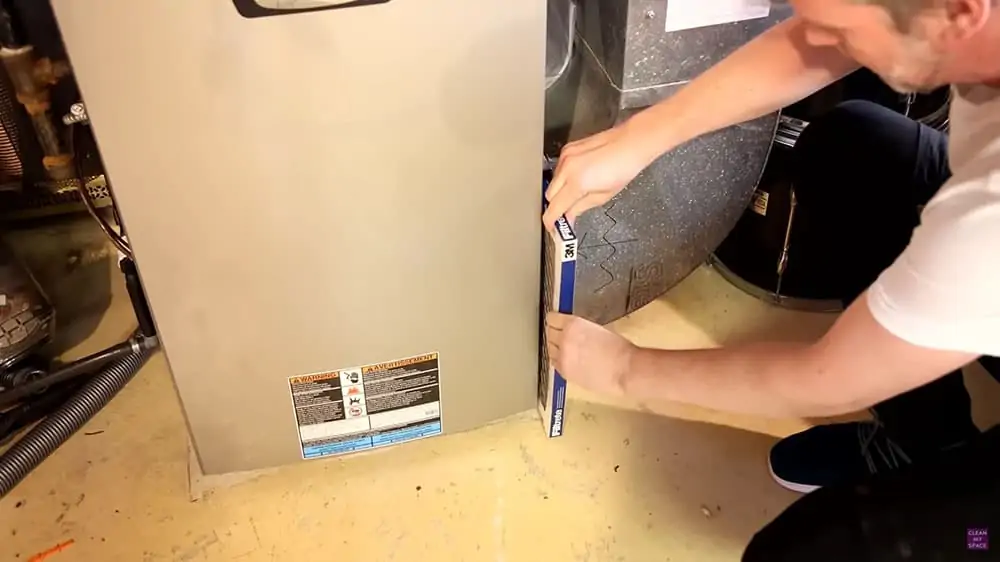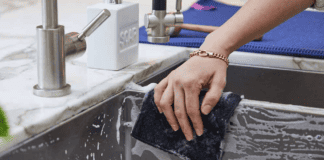Indoor air quality is often one of those health considerations we vaguely know about but never really talk about. Since quarantine life, many of us have been working from home and generally spending more time in our homes. Because of this, people have started to think more about indoor air quality. And if you haven’t yet, you should!
So what is indoor air quality? How can you improve indoor air quality? And what the heck does cleaning have to do with air quality? Keep reading to find out!
Why Indoor Air Quality Is Important
Whether you think about it or not, indoor air quality is actually directly correlated to your health. Indoor air pollutants range from dust and mold to pesticide and asbestos, and more and can cause a host of health problems. Symptoms of poor indoor air quality can include headaches, sinus congestion, and even shortness of breath in serious situations.
It’s much more likely that you have dust mites than asbestos, so don’t stress. But knowing about indoor air quality, why it’s important, and how to improve it is a great way to improve your health and your family’s health.
Many of the most common indoor air pollutants—dust mites, mold, pet dander, and tobacco smoke–can trigger asthma attacks or allergic reactions. If you or a family member has allergies or asthma, you may even notice a reduction in symptoms when you improve your air quality.
What Is Dust, Really?
When you look up the definition of dust, you’ll see that it’s a complex matrix of microscopic organic compounds. For those of us who aren’t scientists, dust is basically hair, skin, bacteria, viruses, pollen, dust mites, and dust mite feces. Yes, feces. Dust mites are microscopic pests that produce up to 20 fecal pellets per day. These pellets can remain airborne for about 30 minutes. Yuck!
While they aren’t pleasant to think about, dust mites themselves are relatively harmless. It’s actually the dust mite feces that contain the allergens so many people are allergic to. Luckily, it’s not that hard to limit your exposure to dust mites. I’ll get into how to do that later in the article.
Volatile Organic Compounds (VOCs)
When I talk about clean indoor air quality, I’m not only talking about dust mites and dust mite feces, and all of that other yucky stuff. I’m also talking about VOCs–volatile organic compounds. These have a major impact on indoor air quality.
VOCs are gases given off by common household products, such as paint and varnish, cleaning and disinfecting products, drapes, fire retardant fabrics, insulation, plywood, particleboard and glue, perfume, hairspray, copiers and printers, and the list goes on.
There are a lot of products we use all the time (hello hairspray!) that affect the air quality in our homes. And if you’re painting or renovating, that means the air quality in your space will actually be quite poor for a short time. Luckily, there are a lot of options to help boost your air quality without tossing all your favorite products and never painting again. We’ll get into all that below.
Indoor Air Quality Testing: What’s Floating in Melissa’s Air
As a cleaning professional, I do some work with the vacuum company Dyson. And when Dyson found out I was interested in clean air quality, they helped me test out my home air quality. Dyson sent me some sample containers and instructed me to vacuum my mattress and living room with the Dyson V11 Outsize. I emptied the contents into the containers and shipped them off to the London School of Hygiene and Tropical Medicine.
The London School put the contents of my containers (literally the dust from my mattress and living room) under a microscope and sent me back a detailed report that was, quite frankly, disgusting. They even included a photo of an actual dust mite that was in one of my containers. This is not the pet I signed up for!
The London School also found: four dust mite legs, one insect egg and body, a strand of cat hair, a flower petal, plant leaves, and bread. As for dust, 5.08 grams of dust from our living room sample and 5.4 grams of dust from our mattress sample. These numbers surprised me, as we vacuum and mop pretty regularly. Plus, I had just filmed my How To Clean A Mattress video just a few weeks beforehand.
This was a great reminder that dust and other icky stuff move around our house. So even if I clean my mattress, if I don’t clean my ceiling fan or my walls or my floors regularly… you get the picture.
Luckily I have some great tips to get rid of those dust mites and bacteria and improve the overall quality of our indoor air.
How Can You Improve Your Indoor Air Quality
You’re probably thinking, OK Melissa, dust is bad. We get it. How do I improve the air quality in my home? And that’s an excellent question I’m going to answer right now with these simple steps.
Dust Mites in Bed!
There are a lot of great reasons to make your bed. And for years, I’ve been making my bed as soon as I get up. Well… maybe not every day but most of the time. But research shows it’s better to let your bedding air out a little before you make the bed. Dust mites and microbes can’t survive exposure, so leaving your bed unmade for a little while in the morning helps kill them off. Try making your bed after you’ve had your morning coffee.

Dust and Clean Regularly
I might sound like a broken record, but dust is a common key contributor to poor indoor air quality. So, dusting, vacuuming, and mopping regularly is important. However, I’m not a fan of sweeping because it kicks up dust that lands on other surfaces in your home.
If you want to splurge, a vacuum with a HEPA filter will remove the most dust particles and pet dander from your home and the air. When dusting, choose a grippy fabric, like a microfiber cloth, that dust will stick to.
Humidity and Mold Prevention for Clean Air
I’ve talked a lot about moisture and bacteria at Clean My Space, most recently in my new blog How to Clean A Bathroom: Professional Cleaning Secrets. Bathrooms are a common area for mold and bacteria growth because they can feel like a tropical rainforest after you take a hot shower. But any room in your home that holds a lot of moisture in the air is vulnerable to mold and bacteria growth.
Mold and fungi are microbes caused by high humidity levels, and they’re actually quite detrimental to your indoor air quality. So always run your bathroom fan for at least 30 minutes after a shower. If you don’t have a fan, make sure to open the window. And in warm, humid months, a dehumidifier can keep your home free from mold and mildew.
Ventilation is Key
Good ventilation in your home means the air isn’t sitting stagnant and full of dust mites and other yucky stuff. This is an easy fix; open your windows! Especially when it’s nice out and while you’re cleaning, give your home some air. Airing out your home when dealing with painting, renovating, or cleaning products will help get rid of those VOCs.
A slightly more labor-intensive trick is to clean or replace your furnace filter. Your furnace has a dirty job and collects airborne dust, hair, and other small particles. If you don’t clean your filter, those particles get blown back into and around your home. So add this chore to your cleaning list for better quality air.

Pets and Indoor Air Quality
If you’re a pet parent, cleaning regularly is extra important for you. Wash pet beds and blankets regularly, but be mindful that pet dander is probably on all the surfaces in your home. Check out my article Pet Cleaning Tips: Pet Items You Should Be Cleaning for more info on this.
I have a Siamese Himalayan cat who is gorgeous and sheds like crazy. I vacuum using a HEPA filter and groom her regularly to mitigate the hair and dander in my space.
Best Air Purifier
If you’re concerned about the air quality in your home or just want to make sure you and your family are breathing clean air, air purifiers are your best friend. My family uses the Dyson Pure Humidify+Cool. This Dyson air purifier senses and captures pollutants and is self-cleaning. If you’ve ever had to disassemble and clean a humidifier before, you’ll understand what a big plus a self-cleaning humidifier is.
Other cool features of the Dyson Pure Humidify+Cool are automatically purifying your air, hygienically humidifying your air, and acting as a fan. And this high-tech purifier connects to an app on your phone, so you can monitor your air quality and control your air purifier straight from your smartphone. The Dyson Pure Humidify+Cool Air Purifier also has a sealed 360-degree filtration system. It combines an activated carbon filter to remove gases and odors and a sealed HEPA filter to capture 99.97 percent of particle pollutants as small as 0.3 microns. This air purifier is excellent for dust mites, pet dander, and VOCs.
When I choose a product, I always balance the price with the quality of the item. If I’m investing in something, I want to make sure that it will do the job it needs to do and last a long time. You can certainly get less expensive air purifiers than this one, but they don’t have nearly the same capabilities as my favorite Dyson air purifier.
When choosing the best air purifier for you, make sure to choose one that will last you a long time and that meets your preferences. And always be mindful of what type of maintenance your air purifier will require, including cleaning. You don’t want to invest in an expensive appliance that will be difficult to clean or break after a year.
How to Improve Your Indoor Air Quality
Improving your indoor air quality will improve your health and your family’s health, and you can’t beat that. Plus, you might find that your asthma or allergies diminish when you clean your air.
Keeping your indoor air quality at a healthy level is really just a matter of keeping your home clean and using a few extra gadgets for that additional protection. I hope this article taught you more than you’ve ever wanted to know about dust mites and how to keep your air fresh and clean.
Looking for a BETTER & EASIER Way to Clean Your Home?
Cleaning Expert Melissa Maker is here to help with her game-changing 3 Wave Cleaning System that will help you clean your house faster and easier than you ever thought possible!


















Thank you for the tips! Another suggestion I’d like to make is to consider using HEPA filters for your home’s air conditioner. However, it’s important to be selective when choosing one for your system.
The effectiveness of HEPA filters is measured by their MERV rating. While high-rated filters are more efficient at capturing small particles, they can also restrict airflow and cause your system to work harder, resulting in higher energy consumption. For most homes, HEPA filters with a MERV rating between 6 and 13 should work fine.
Also, consider cleaning your air ducts. A good rule of thumb is to schedule an air duct cleaning every 5-7 years.
[…] Windy, chilly, smoky, dry, or dusty environments can exacerbate all of the signs related to DES as a result of they have an effect on tear manufacturing by growing evaporation. The extra time you spend in a dangerous atmosphere, the harder it turns into to tolerate dry eye signs. Ideally, you need to dwell and work in a spot with moist and clean air. […]
[…] Windy, cold, smoky, dry, or dusty environments can exacerbate all the symptoms associated with DES because they affect tear production by increasing evaporation. The more time you spend in a harmful environment, the more difficult it becomes to tolerate dry eye symptoms. Ideally, you should live and work in a place with moist and clean air. […]
The blog is helpful for everyone. It provides useful information to all readers.